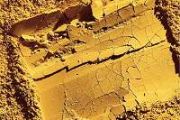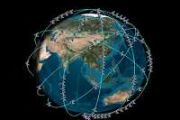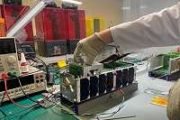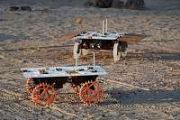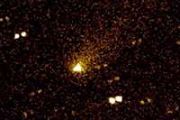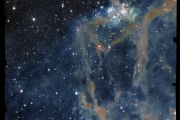
Copernical Team
NASA's Fermi detects first gamma-ray eclipses from 'Spider' Systems
 Scientists have discovered the first gamma-ray eclipses from a special type of binary star system using data from NASA's Fermi Gamma-ray Space Telescope. These so-called spider systems each contain a pulsar - the superdense, rapidly rotating remains of a star that exploded in a supernova - that slowly erodes its companion.
An international team of scientists scoured over a decade of Fermi
Scientists have discovered the first gamma-ray eclipses from a special type of binary star system using data from NASA's Fermi Gamma-ray Space Telescope. These so-called spider systems each contain a pulsar - the superdense, rapidly rotating remains of a star that exploded in a supernova - that slowly erodes its companion.
An international team of scientists scoured over a decade of Fermi Starry tail tells the tale of dwarf galaxy evolution
 A giant diffuse tail of stars has been discovered emanating from a large, faint dwarf galaxy. The presence of a tail indicates that the galaxy has experienced recent interaction with another galaxy. This is an important clue for understanding how so called "ultra-diffuse" galaxies are formed.
Astronomers using the Subaru Telescope and the Canada-France-Hawaii Telescope found a tail of star
A giant diffuse tail of stars has been discovered emanating from a large, faint dwarf galaxy. The presence of a tail indicates that the galaxy has experienced recent interaction with another galaxy. This is an important clue for understanding how so called "ultra-diffuse" galaxies are formed.
Astronomers using the Subaru Telescope and the Canada-France-Hawaii Telescope found a tail of star RIT scientists reach a milestone in the search for continuous gravitational waves
 Scientists on the hunt for a previously undetected type of gravitational waves believe they are getting close and have refined techniques to use in upcoming observational runs. Researchers from the LIGO-Virgo-KAGRA Collaboration outlined the most sensitive search to date for continuous gravitational waves from a promising source in a paper recently published in the Astrophysical Journal Letters.
Scientists on the hunt for a previously undetected type of gravitational waves believe they are getting close and have refined techniques to use in upcoming observational runs. Researchers from the LIGO-Virgo-KAGRA Collaboration outlined the most sensitive search to date for continuous gravitational waves from a promising source in a paper recently published in the Astrophysical Journal Letters. NASA selects nine technologies for commercial flight tests
 selected nine space technologies for flight testing to advance innovations that address mission needs for both the agency and the commercial space industry.
Selected as part of the NASA's 2022 TechFlights solicitation, these technologies will fly aboard commercial suborbital vehicles such as high-altitude balloons, aircraft following parabolic flight profiles, suborbital rocket-powered sys
selected nine space technologies for flight testing to advance innovations that address mission needs for both the agency and the commercial space industry.
Selected as part of the NASA's 2022 TechFlights solicitation, these technologies will fly aboard commercial suborbital vehicles such as high-altitude balloons, aircraft following parabolic flight profiles, suborbital rocket-powered sys Searching for buried treasure on Mars with RIMFAX
 What do the Perseverance rover and Superman have in common? They both can "see" through solid rock! Superman has X-ray vision whereas Perseverance has RIMFAX, a ground penetrating radar or GPR, located on the lower rear of the rover. RIMFAX uses radio waves to image the subsurface rock layers as the rover drives along.
It is the first instrument of its kind sent by NASA to Mars and can "se
What do the Perseverance rover and Superman have in common? They both can "see" through solid rock! Superman has X-ray vision whereas Perseverance has RIMFAX, a ground penetrating radar or GPR, located on the lower rear of the rover. RIMFAX uses radio waves to image the subsurface rock layers as the rover drives along.
It is the first instrument of its kind sent by NASA to Mars and can "se Data from the first SLS flight to prepare NASA for future Artemis missions
 NASA continues to evaluate data and learn more about the Space Launch System (SLS) rocket's debut performance during the agency's Nov. 16 Artemis I launch. Following an initial data assessment and review that determined the SLS rocket met or exceeded all performance expectations, SLS engineers are now taking a closer look at the Moon rocket's performance to prepare for the first crewed Artemis m
NASA continues to evaluate data and learn more about the Space Launch System (SLS) rocket's debut performance during the agency's Nov. 16 Artemis I launch. Following an initial data assessment and review that determined the SLS rocket met or exceeded all performance expectations, SLS engineers are now taking a closer look at the Moon rocket's performance to prepare for the first crewed Artemis m NASA's Juno Team assessing camera after 48th flyby of Jupiter
 The JunoCam imager aboard NASA's Juno spacecraft did not acquire all planned images during the orbiter's most recent flyby of Jupiter on Jan. 22. Data received from the spacecraft indicates that the camera experienced an issue similar to one that occurred on its previous close pass of the gas giant last month, when the team saw an anomalous temperature rise after the camera was powered on in pre
The JunoCam imager aboard NASA's Juno spacecraft did not acquire all planned images during the orbiter's most recent flyby of Jupiter on Jan. 22. Data received from the spacecraft indicates that the camera experienced an issue similar to one that occurred on its previous close pass of the gas giant last month, when the team saw an anomalous temperature rise after the camera was powered on in pre Solar System formed from 'poorly mixed cake batter'
 Earth's potassium arrived by meteoritic delivery service finds new research led by Carnegie's Nicole Nie and Da Wang. Their work, published in Science, shows that some primitive meteorites contain a different mix of potassium isotopes than those found in other, more-chemically processed meteorites. These results can help elucidate the processes that shaped our Solar System and determined the com
Earth's potassium arrived by meteoritic delivery service finds new research led by Carnegie's Nicole Nie and Da Wang. Their work, published in Science, shows that some primitive meteorites contain a different mix of potassium isotopes than those found in other, more-chemically processed meteorites. These results can help elucidate the processes that shaped our Solar System and determined the com Iceberg larger than London breaks off Brunt
 Video:
00:04:25
Video:
00:04:25
An iceberg around the size of Greater London broke off Antarctica’s Brunt Ice Shelf due to a natural process called ‘calving’. The iceberg, measuring 1550 sq km, detached from the 150 m-thick ice shelf a decade after scientists first spotted massive cracks in the shelf.
For more information on the newly-birthed A81 iceberg, click here.
Lockheed Martin achieves first light in latest laser lab demonstration
 Lockheed Martin achieved first light from the Directed Energy Interceptor for Maneuver Short-Range Air Defense System (DEIMOS) system, which verifies that the laser's optical performance parameters align with the system design parameters.
Lockheed Martin's 50 kW-class DEIMOS system is a ruggedized, tactical laser weapon system that can be integrated into the Stryker combat vehicle to deliv
Lockheed Martin achieved first light from the Directed Energy Interceptor for Maneuver Short-Range Air Defense System (DEIMOS) system, which verifies that the laser's optical performance parameters align with the system design parameters.
Lockheed Martin's 50 kW-class DEIMOS system is a ruggedized, tactical laser weapon system that can be integrated into the Stryker combat vehicle to deliv 
